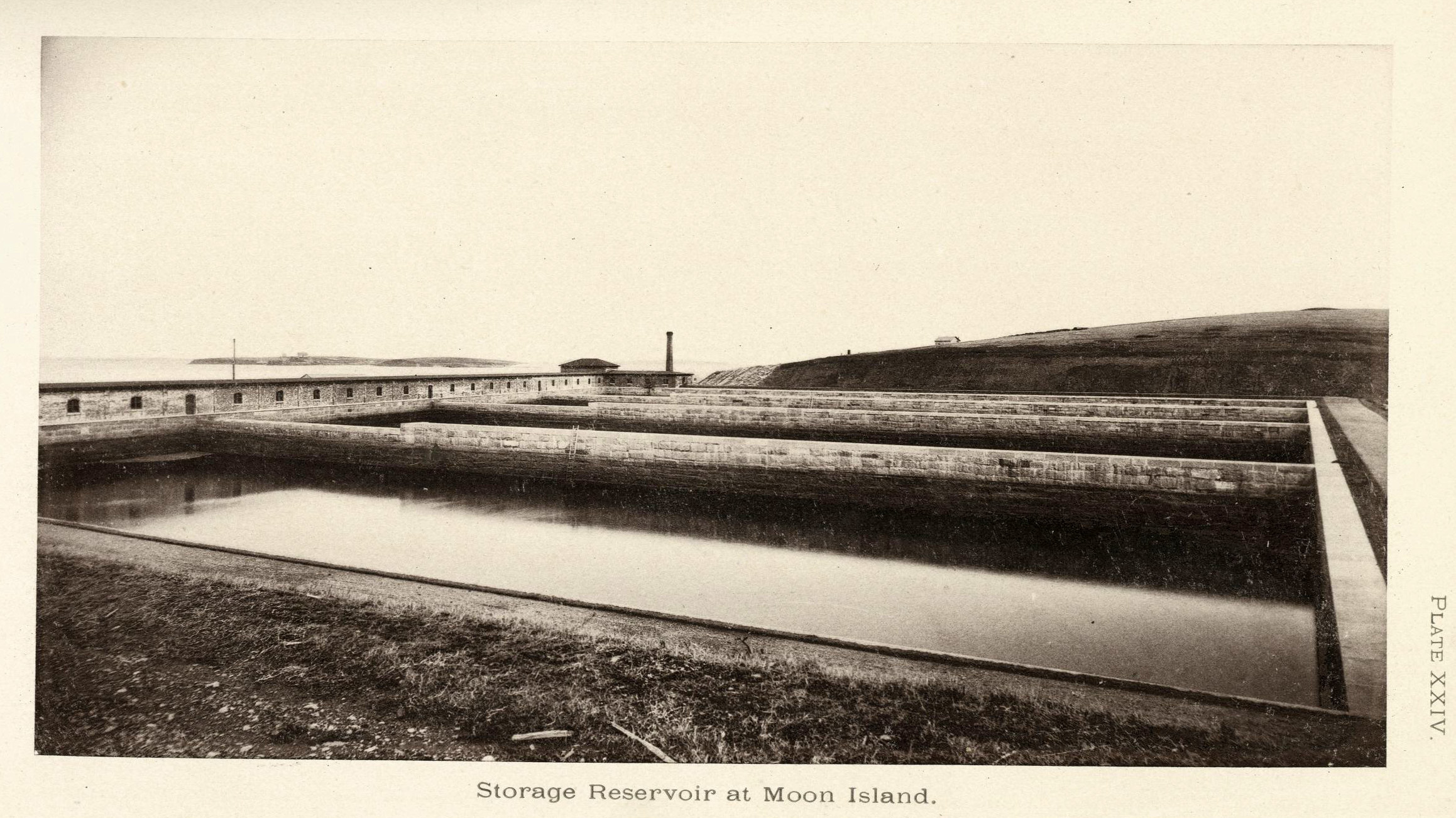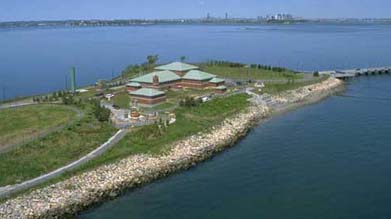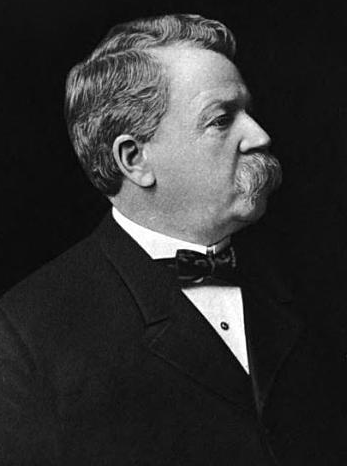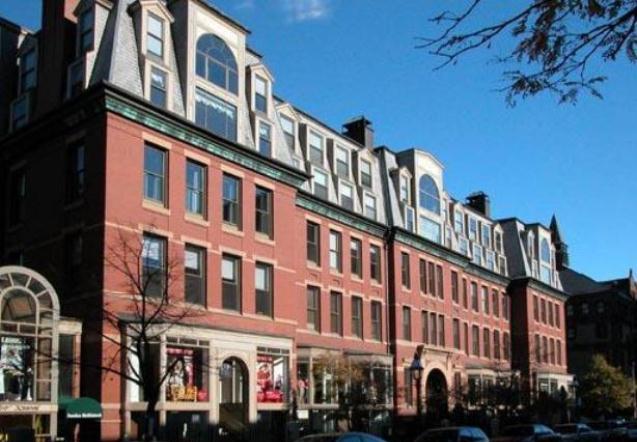
View Calf Pasture Pumping Station in a larger map
This map shows sites related to the Calf Pasture Pumping Station, including:
Moon Island

The City of Quincy housed the Moon Island sewerage facility. Moon Island served as the final destination for Boston’s sewage until 1968 when the city updated the Deer Island facility to handle the main drainage sewage. Reservoirs on Moon Island collected the raw sewage transported from the Calf Pasture Pumping Station. Here, reservoirs held sewage until releasing it into Boston Harbor with the outgoing tide.
Decades of dumping the city’s untreated sewage had negative impacts on Boston Harbor and local communities. Attempts to redress this pollution began In 1941, with the design of a waste treatment facility at Nut Island. Ernest efforts to clean the harbor began in the 1970s.
Nut Island

It took seven years to build the sewerage treatment plant at Nut Island, in the City of Quincy; construction began in 1945, and operations commenced in May 1952. Total construction costs were approximately $10 million.
Engineers designed the Nut Island sewerage facility to address environmental problems created by the release of untreated sewage into Boston Harbor. The Nut Island plant built in 1952 could not provide sufficient sewage treatment to protect the waters of Boston Harbor, however. Prompted by a lawsuit and investigation in 1982, the 1952 facility at Nut Island was demolished, and a new Nut Island Headworks facility opened in 1998. This newer facility can complete a secondary treatment of sewage, and thus remains in operation today. The Massachusetts Water Resource Authority maintains a public park on the island.
Deer Island

The facility on Deer Island in Boston Harbor is perhaps the most easily recognizable sewerage treatment plant in Boston. The distinctive large round tanks are readily spotted from airplanes, boats, and land across the harbor. The first primary treatment plant at Deer Island was built in 1968. In 1982, the establishment of the Massachusetts Water Resources Authority (MWRA) led to the rehabilitation of sewerage treatment facilities on both Nut Island and Deer Island to create plants that could sufficiently treat Boston’s sewage for safe release into the Harbor.
Sources Consulted:
Photo Credits:

Architect George Albert Clough designed the Calf Pasture Pumping Station. Appointed the first City Architect of Boston in 1874, Clough oversaw the design, construction, and renovation of a number of prominent public structures in Boston during his nine-year tenure. These included: Boston Latin School, Boston English School, Suffolk County Courthouse, Congress Street Fire Station, and the Prince School on Newbury Street. Clough also submitted the first plans to be accepted for the Boston Public Library in 1880, and oversaw the first restoration of the Massachusetts State House in 1881. He played a role in the design of the waterworks systems in Chestnut Hill and Framingham, which provided Boston with a much needed alternate water source.
Born on March 27, 1843 in Blue Hill, Maine, Clough began his career working as a draughtsman for his father, who was a shipbuilder. After his father’s death in 1863, Clough moved to Boston to formally study architecture. He was employed and trained at the firm of Snell and Gregerson, where he stayed until 1869, when Clough left to open his own architectural office. He held the office of City Architect from 1874 to 1883.
((

The Calf Pasture Pumping Station was George Clough’s final project as Boston’s City Architect, as its construction was awash with controversy. Clough and the Superintendent of Sewers, William H. Bateman, approved the plans for the Main Drainage Works System presented by Ellis S. Chesbrough and his commission in 1876, and construction began on the Calf Pasture in 1879.
The City Council expected the construction of the facility would be carried out by skilled craftsmen from Boston. But, Clough dismissed the primary laborers and replaced them with men of his choosing; this sparked controversy, as the members of Boston City Council believed Clough’s new men were poor craftsmen.
Earlier, in 1881, an alderman on the City Council had accused Clough of neglecting improvements in the ventilation of the Council Chambers of City Hall, and called for his replacement as City Architect. On April 9, 1833, Clough lost the council re-election as city architect; he was replaced by Charles J . Bateman (1851-1940) who oversaw the completion of the pumping station.
After his removal from the post of city architect, Clough returned to private practice. In 1905 he established the firm Clough and Wardner and went on to design some 84 public schools in Massachusetts, New York, Maine, and Pennsylvania. He died in Brookline, Massachusetts in January 1911. Fourteen buildings designed by Clough, including the Calf Pasture Pumping Station, are now on the National Register of Historic Places.
Sources Consulted:
Boston City Council. Reports for the Proceedings for Municipal Years 1876, 1883, 1885. Boston: Rockwell and Churchill.
Clark, Eliot C. Main Drainage Works of the City of Boston. Boston: Rockwell and Churchill, 1885.
Engineering News and American Contact Journal, February 17, 1883, pg 163.
National Register of Historic Places Registration Form for the Calf Pasture Pumping Station.
Obituary of George Clough, Ellsworth (Maine) American, January 11, 1911, p. 6.
Marwell, Stuart; Burke, Bryan; Hudak, Andrew, “Calf Pasture Pumping Station”, Boston Public Library, BRA (Boston Redevelopment Authority) collection
Photo Credits:

Before 1879, the Boston peninsula today known as Columbia Point, consisted of fourteen acres of marshy land. During the 19th century Dorchester residents used this land for grazing cattle, and was thus known by residents as simply the “Calf Pasture.” The Puritans first landed nearby at the place known as Mattaponnock, today’s Savin Hill.
In the 1879s, city leaders and commissioners chose the Calf Pasture for the site of the pumping station that was vital to the new sewerage system. Why here? The peninsula was distant from the more heavily populated areas of Boston, and the city could acquire it at a low cost. It was also close to the water and Moon Island, south of the city in Quincy, where the sewage would be released.
In 1879, the city initiated several land making projects on the peninsula, to prepare the area for the construction of the new sewage pumping station that would be the centerpiece of Boston’s Main Drainage Works sewerage system. The system was completed in 1884, when the Calf Pasture Pumping Station began working continuously to remove waste away from Boston.
In 1884, the Main Drainage Pumping Station and its several outbuildings were the only structures on the peninsula. The castle-like structure of the Pumping Station stood out on the marshy lands of Calf Pasture; it was accessible only by “Mile Road,” today known as Mount Vernon Street. During the 1880s, landmaking accommodated the construction of several Bay State Gas Company gas tanks just south of the Calf Pasture.
In the 20th century, more land resulted from filling in the flats at the end of the Calf Pasture and along the coast between Calf Pasture and Savin Hill for the construction of “Old Colony Boulevard,” now William T. Morrissey Boulevard, which opened to automobile traffic in 1928.
In 1942, a military camp was built on the peninsula. During the Second World War, Camp McKay housed Italian prisoners of war. After the war, the camp’s barracks were repurposed as public housing, known as the “Columbia Village housing project”.
Boston College High School relocated from the South End to Dorchester in 1950. In 1958, the Boston Globe relocated its operations to Morrissey Boulevard, just across the street from the Boston College High School, at the edge of Columbia Point. The barracks-turned-public housing were demolished soon after to make way for a shopping center and the Calf Pasture thus became known as Columbia Point.![]()
The peninsula saw even further changes in the last quarter of the 20th century. In 1974, the pumping station (by then unused), had another new neighbor when University of Massachusetts Boston officially opened its doors to students on their new campus at Columbia Point. The John F. Kennedy Presidential Library and Museum was established in 1979, and the Massachusetts State Archives opened in 1985. In the late 1980s, developers transformed the Columbia Point housing project into the Harbor Point community. By 1990, Calf Pasture was a vastly different place than when the pumping station was built. Certainly entirely different from when the Puritans first landed nearby the place known as Mattaponnock, the peninsula’s modern day neighbor, Savin Hill.
Sources:
Photo Credits:

Calf Pasture Pumping Station Timeline
1875
1877-1884
1879
1883
1884
1889
1880s-1930s
1919
1940
1946
1953
1952
1968
1971
1975
1977
1979
1985
1986
1990
1995
2007
2011
1. Clark, Eliot C. Main Drainage Works of the City of Boston. Boston: Rockwell and Churchill, 1885.
2. Kennison, Karl R. “Sewage Works Development in the Massachusetts Metropolitan District.” Sewage and Industrial Wastes 22.4 (1950): 477-89. JSTOR. Web. 06 Mar. 2013.
3. Marwell, Stuart. Calf Pasture Pumping Station. N.p.: n.p.
4. National Register of Historic Places, Calf Pasture Pumping Station Complex.
5. Roessner, Jane. A Decent Place to Live: From Columbia Point to Harbor Point: A Community History. Boston: Northeastern UP, 2000.
6. Taylor, Earl. “Calf Pasture Pumping Station.” Dorchester Atheneum.
Footnotes:
1. “Sudden Destruction: A Terrible Tornado Along the Whole Atlantic Coast.” The Washington Post, 08/20/1879.